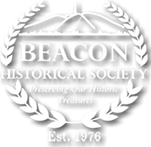Lost Landmarks of Beacon in Postcards
Beacon was the largest hat manufacturer in the state of New York, and second in the country to Danbury CT. For nearly 100 years starting in 1864, hat factories employed thousands of workers who made hundreds of thousands of hats in a myriad of styles. Its heyday was between 1920 and 1940. The majority of the factories were razed, some are in ruins and others, such as Two East Main Street were refurbished into apartments or condos.
Information about the lost landmarks of Beacon was gleaned from the book Beacon’s Memory Keeper and Storyteller: Robert J. Murphy. The “Lost Landmarks” article originally appeared in the Highlands Current newspaper www.highlandscurrent.org. Postcard images are from the collection of Peter and Diane Lapis.
The Newburgh-Beacon ferry line ran for 220 years… one of the longest running in American history. The “modern” ferry terminal was built in 1914 and closed in 1963 with the opening of the Newburgh-Beacon Bridge. It was razed in 1968. The NY Central Railroad built the two-story brick stationhouse in 1915. It was destroyed by fire in 1975. Nothing remains of the plaza today, but residents and visitors who travel on the MetroNorth Railroad or ride the Newburgh-Beacon Ferry follow in the path of thousands of travelers before them.
Only ruins of the Beaconcrest Hotel, Casino, power station, and rails remain visible to hikers on top of Mt. Beacon. The Incline and casino opened to 60,000 guests during its first season in 1902. The three-story hotel was built six years later making it a top destination in the Hudson Valley. A fire destroyed the casino and hotel in 1927. In 1981 and 1983, fires destroyed the power station, cars, and tracks.
Opening in 1894 and razed in 1972, this 50-room three-story red brick with bluestone trim building was considered the most distinctive on Main Street and the best hotel in the twin villages of Fishkill Landing and Matteawan. The Dutchess County Government offices and a parking lot stand where this once majestic building held court for almost 80 years.
Opened in 1891 with 12 classrooms and a huge assembly room, the Fishkill Union Free School welcomed 438 students from primary, grammar, and other academic departments. Fire destroyed the building in January 1928. Within a year, a new structure took it place called South Avenue School.
Originally founded in 1878 by Mrs. Henry Winthrop Sargent at her home at Wodenethe, the Industrial School provided classes in the domestic arts and sciences for girls (ages 7-18). The school was innovative for its time, providing opportunities for young women to escape poverty by developing marketable skills. The school closed in 1918 upon Mrs. Sargent’s death. Her education vision was not forgotten. Soon after, a domestic science department was installed on the top floor of the Fishkill-on-Hudson School. Wodenethe, located opposite the Sargent School property, is now a neighborhood of single-family homes.
A seasonal community of twenty families stayed on top of Mt. Beacon in small cottages during the hotel and Incline’s heyday from the 1900s to 1920. Trolley cars delivered the guests and all their needs to enjoy the cool refreshing air on the mountain. Today, only one cottage remains, albeit in ruins, and can viewed by hikers along Howard’s Path.
Long Dock Railroad Terminal wore many hats from 1880 to present day: a rail terminal and docking area for the train transport ferry William T. Hart, a key link in the New Haven Railroad, a pig iron transfer station, fuel storage site, salt stockpiles, and an automobile junkyard. Today it is the home of picturesque Long Dock Park owned by Scenic Hudson.
In 1871, General Howland purchased a home on Washington Street (now Russell Avenue) and gifted it to the city as a hospital. By 1900, it was deemed inadequate and a new hospital was built on Verplanck Avenue. The building depicted on this postcard was razed in 1960. A group of townhouses stands in its stead.
Stone remains of the Tioronda Railroad Bridge can be seen going north at Madam Brett Trail Park near South Avenue near the old Tioronda Chapel on the Howland Estate. The trestle was built in the late 1860s by the Dutchess and Columbia Railroad and crossed at Sucker Falls. It connected the railroad spur line at Wiccopee Junction located just below the NY Rubber Co. to its terminal at Dutchess Junction. When the Dutchess Junction terminal closed, the trestle went into disuse and was torn down in 1920.
Located on Route 9D in Dutchess Junction, Nitgedaiget was a vacation resort for Jewish progressive liberals and Communist sympathizers from 1922 to the early 1950s. The complex included a four-story hotel, dining hall, casino/dance hall, business office, pool, sports facilities, bungalows, and tents, accommodated 1,000 people a day. Originally a 250-acre property, it is now under the aegis of the Hudson Highlands State Park. Remains of the pool can be seen off of the Notch Trail.











